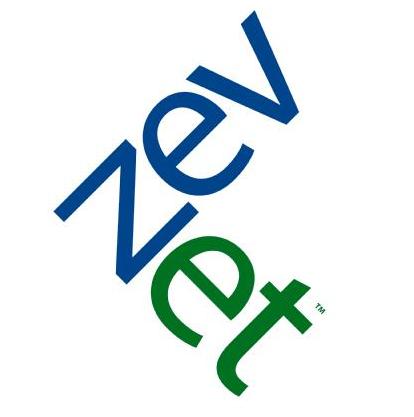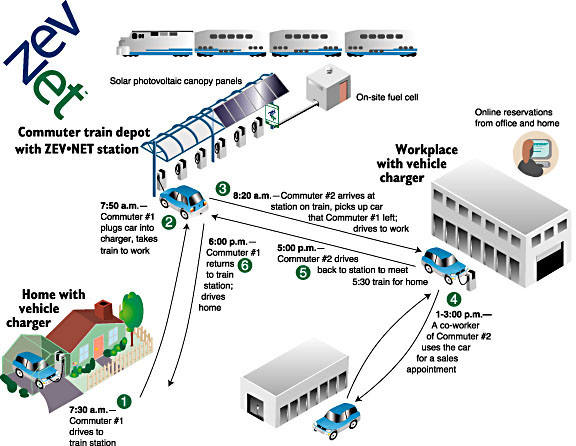

a brilliant concept for commuters
 |
 |
ZEV•
NET a brilliant concept for commuters | ||
ZEVNET -- Zero Emission Vehicles Network Enabled Transportation
The Holy Grail of many transportation professionals is a viable transportation alternative to the automobile, possibly both the most praised and condemned technology ever widely-deployed and certainly the primary influence today on the structure of urban form and everyday life in developed countries. While many inferior alternatives have been proposed in various guises, most often some form of public transit, the evolving consensus has been that unless the automobile is made less attractive, then no other alternative presents a realistic travel option. The automobile has remained steadfast in its dominance of the market for virtually all travel, including commuting. In most metropolitan areas, commuting corridors are increasingly characterized by excessive delays, a degradation in air quality, and an increased consumption of energy.
An increasingly favorable alternative appeals to the benefits of the automobile (flexibility, personal autonomy, etc.) while simultaneously minimizing the costs (a range of environmental impacts) by actually being an automobile, but an automobile which is utilized in unique ways. Shared use automobiles and station car concepts have seen limited yet somewhat successful applications internationally, albeit in essentially niche markets (see Shaheen et al., 1998; Shaheen, 1999). A shared-use vehicle is owned and utilized by a group of drivers who share costs and benefits, often organized as a cooperative entailing membership and use fees. A station car is most often simply a car which is used between a residence and a transportation center/station (most often with rail systems) or a transportation center/station and an employment center. The car provides access to and from the line haul mode, and many commuters have found this a convenient way to cover long commutes while maintaining the benefits of a car at one or both ends of the trip (see http://www.stncar.com/).
There are limitations to these concepts, most a direct result of the "ownership" model associated with the American automobile. Particularly on the work commute, when you get in your car, you're already half way home. This satisfaction is not the same on public transit systems nor in most shared car systems. Station cars do not really address related transportation impacts since total vehicle usage and parking demand are not significantly reduced (although it may enable increased commuting by other modes).
A synthesis of these concepts is proposed, with a few other catalysts thrown in for good measure. The primary catalyst is the current State of California Zero Emission Vehicle (ZEV) mandate, which has legislated a proportion of total annual automobile sales for major manufacturers be ZEVs (see http://www.zevinfo.com/electric/electric.html). The program requirements as released by the California Air Resource Board in 2001 provide for a credit system where electric vehicles (EVs) receive added credits toward manufacturer quotas if they are utilized in either an integrated multi-modal transportation system and/or an Intelligent Transportation System (ITS) program.
As an initial foray into such programs, the Advanced Power and Energy Program (APEP) and the Institute of Transportation Studies (ITS) at the University of California, Irvine entered into Phase 2 of a three phase program investigating the feasibility of deploying city electric vehicles in shared-use and station car modes within a corporate management structure. This program is the subject of the research, development, and evaluation effort underway. This effort initially focuses on the implementation of novel survey systems in each ZEVNET electric vehicle to track vehicle trajectories and to subsequently survey individual drivers, and their households, relative to their use of the cars and the associated impact on household travel behavior. In a nutshell, can a shared-use station car program actually reduce the environmental impacts of the current automobile-dominated transportation system and help to achieve the goals of California's ZEV mandate?
In response to the California ZEV mandate, a consortium of researchers, manufacturers, and state agencies is developing an intelligent transportation system that will use wireless networks to link small electric vehicles to corridor rail transportation in the form of shared-use station cars. This will take advantage of the corridor's natural potential for rail travel for the line haul portion of many commutes, while still providing commuters with the mobility and flexibility they demand at both ends of that line haul. This hub and spoke access system, once successfully implemented to serve commuter rail corridors, can be extended to office parks, entertainment complexes, and residential neighborhoods.
The demonstration project proposed is designed to:
Phase 1 and 2
In Phase 1 of the prototype system, 15 Toyota ecom "city" electric vehicles
were distributed to participating companies in UCI's University Research Park
where individual drivers were assigned a vehicle for private use for one month.
At the end of this six month "introduction" period, the vehicles were removed
for subsequent re-allocation to the same companies but in a shared use mode.
It is at this stage, Phase 2, that the REACT! and TRACER technologies are
being applied. Each participating company will receive one to three ecoms
which will be shared among all participating drivers during the conventional
work day. Selected drivers will have access to the vehicles at night and on
week-ends and, in particular, will be able to access free preferred parking
with EV chargers at the Irvine Transportation Center (served by Amtrak and
MetroLink commuter rail). A full implementation of ZEV NET (Zero Emission
Vehicles - Network Enabled Transportation) is to be realized in Phase 3 where
full prototype development of the necessary information technology will be
implemented in a fleet of EVs deployed at several regional transportation
centers which feed the Irvine employment centers.
Schematic of ZEV•NET Operations

